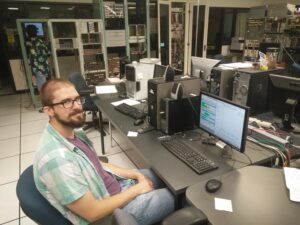Category Archives: NC State
Correlated Energies in Reaction Rates
The synthesis of the elements in stars depends on our ability to accurately measure nuclear reaction cross sections in the laboratory. For over a decade, the NCSU nuclear physics group has been leading an effort to quantify the astrophysical uncertainties that arise from those measurements. In our latest development, we investigated ways to include systematic energy errors in the calculations. The paper detailing these calculations was recently published in Astronomy and Astrophysics here.
 Figure showing the effect of correlated and anti-correlated resonance energies on the calculated rate of a nuclear reaction. On the left, correlated energies create a net increase in the rate (solid black curve), while for anti-correlated energies the effect is cancelled out.
Figure showing the effect of correlated and anti-correlated resonance energies on the calculated rate of a nuclear reaction. On the left, correlated energies create a net increase in the rate (solid black curve), while for anti-correlated energies the effect is cancelled out.
Caleb Marshall wins Graduate Research Assistant Award
Caleb Marshall, who works in Dr. Longland’s research group, recently won the NCSU Physics Department’s Outstanding Research Assistant award for his great work at the Enge Split-pole Spectrograph at TUNL. Caleb’s contribution to our program has helped establish our research group as one of the world leaders in performing high-resolution particle transfer measurements for astrophysics. Congratulations, Caleb!

First COHERENT Germanium array detectors delivered
The first COHERENT Germanium array detectors have been delivered! This is a 2 kg detector, the first of 8. We will be characterizing this detector and the others as they are delivered, and will then ship them to ORNL for installation in shielding and measurement of CEνNS.

Paper published on constraining the 25Al(p,g) reaction
Dr. Longland’s research group and their collaborators at the University of Edinburgh, UK, have recently had their paper on constraining the 25Al+p reaction rate in classical nova explosions. By studying the 25Mg(d,p)26Mg, excited states in the mirror nucleus were populated and neutron spectroscopic factors were extracted. We measured the spectroscopic factor of the key 0+ resonance and set a stringent upper limit on the 1+ resonance. The result of these findings is a dramatic decrease of the reaction rate below 200 MK.
The paper will be published soon in the European Journal of Physics A.


